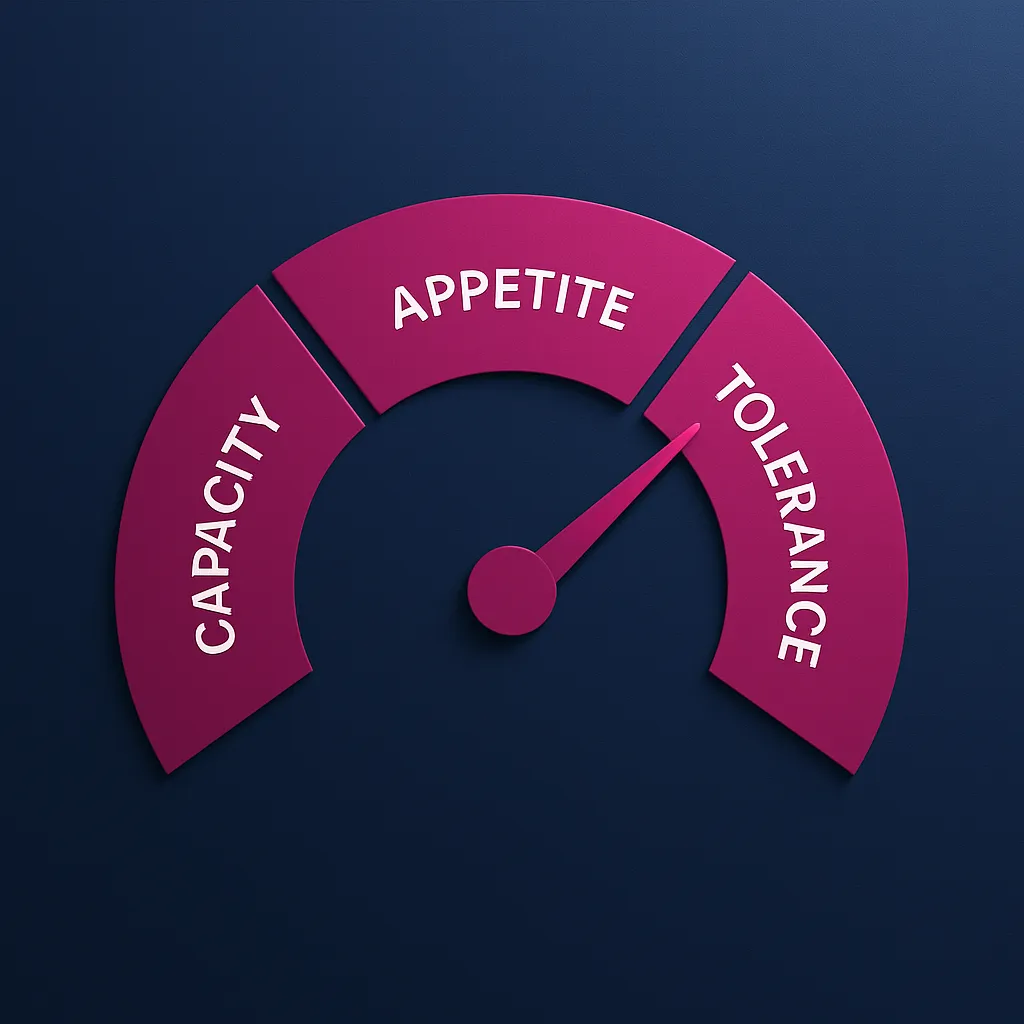Risk Appetite vs. Risk Tolerance: Clarifying the Confusion
Imagine approving a €20 million cloud migration yet never asking, “How much loss can we absorb if it fails?” Boards that skip this question drift between excessive caution and reckless bets.
The Risk Hierarchy
Risk capacity – the hard ceiling: maximum loss the organisation can take before breaching capital, liquidity, or licence requirements. Risk appetite – the strategic target set inside that ceiling: how much risk leadership willingly pursues to achieve objectives. Risk tolerance – the operational guard-rail: the point at which automated responses must trigger (stop-loss orders, disaster-recovery playbooks).
Capacity is dictated by economics, appetite is voluntary, tolerance is monitored. Align all three and no project can outrun the balance sheet.
The Appetite–Tolerance Ladder
| Scenario | Appetite (green zone) | Tolerance (red line) |
|---|---|---|
| Cyber outage | ≤ 4 h total downtime per year | Escalate if a single outage hits 1 h |
| Trading loss | ≤ 3% daily Value at Risk (VaR) | Auto-close positions at 5% loss |
| Reputation hit | ≤ 1 front-page negative per quarter | CEO statement if two occur |
Numbers beat adjectives; they let directors debate where to place the line, not whether it exists.
Calibrating Appetite Inside Capacity
1. Capital-at-Risk Ratio
Set forecast worst-case loss ÷ free cash (or regulatory capital) to a fixed percentage - often ≤ 10%. Appetite must sit well below that threshold.
2. Risk-Velocity Buffer
The quicker a threat materialises, the smaller the safe margin. Cyber and FX risk may demand appetite at only 30% of capacity, whereas slow-burn geopolitical risk could tolerate 60%.
3. Strategy Premium
Raise appetite selectively where upside is mission-critical - breakthrough R&D, first-to-market launches - while keeping routine operations close to tolerance.
Same Threat, Different Philosophies
BankCo (steady-yield model)
- Capacity capped by Tier 1 capital rules.
- Appetite: ≤ 2% daily VaR; payment-switch RTO 30 minutes.
- Tolerance: any system outage > 15 minutes triggers incident command.
ShopFast (high-growth e-commerce)
- Capacity measured by cash-burn runway.
- Appetite: ≤ 6% daily VaR; website RTO 4 hours.
- Tolerance: 60-minute outage forces rollback; > 2 hours opens a war room.
Appetite mirrors strategy, tolerance mirrors capability, capacity mirrors reality.
Diagnostic Questions for Boards
- Capacity fit – Would the worst credible loss leave us above regulatory and debt-covenant limits?
- Alignment – Does the stated appetite correspond to the risk-weighted capital we budget?
- Signal latency – How quickly does management see data that shows tolerance is being approached?
- Compensation linkage – Do executive incentives reinforce staying within appetite, or reward boundary-pushing?
- Refresh cycle – Has the board reviewed appetite against emerging risks (AI, climate, supply-chain fragility) in the last 12 months?
A “yes” to all five means appetite lives in decision-making, not in a binder.
Embedding Appetite in Performance Management
- Translate into KPIs – Turn each appetite sentence into a metric on the same dashboard as revenue and EBITDA.
- Use leading indicators – Pair lagging loss measures with leading metrics (patch cadence, phishing-click rate, supplier-on-time score).
- Cascade thresholds – Push tolerance numbers into frontline runbooks: service-desk scripts, auto-scaling rules, trading algorithms.
- Board-ready visuals – Show capacity, appetite, and live exposure on a single gauge; directors see drift at a glance.
Try This
- Draft: “We can accept up to ___ % loss of ___ as long as we stay within ___.”
- Pick two proof metrics - VaR % and maximum downtime hours work for most sectors.
- Ask a peer if they would bet their bonus on those numbers. If not, revise.
Clarify ceiling, target, and guard-rail once, and every budget, release, and acquisition will echo the same risk philosophy.
Aligning Risk Philosophy with Corporate Strategy & Values
Your annual report might trumpet “customer obsession” and “innovation at speed,” but if every code change waits four weeks for sign-off the risk message is: move slowly and break nothing. Translating words on a values poster into lived decision rules is the work of risk alignment.
From Motto to Metric in Four Steps
-
Name the core value Example: “Innovation at speed.”
-
State the strategic objective that proves you mean it Ship a new product feature every two weeks.
-
Define a risk objective that protects the strategy Limit release rollback rates to ≤ 2% and mean-time-to-restore (MTTR) to < 30 minutes.
-
Select the confirming KPI Track MTTR on the same dashboard as feature-velocity.
Repeat the sequence for each top-five value.
Anything without a risk objective is just marketing copy.
Narrative Proof: Two Firms, One Storm
When the Log4Shell vulnerability erupted, both AlphaBank and ShopKart shut down customer portals for patching.
-
AlphaBank had long embedded operational resilience into its appetite. Downtime budget was four hours per year, with 30-minute tolerance per incident. Because the patch window fit inside those limits, the board approved the outage in 20 minutes and customers saw a brief “scheduled maintenance” banner.
-
ShopKart professed “always-on convenience” but had never tied that promise to risk appetite. No tolerance existed for an emergency shutdown, and customer churn risk hadn’t been quantified. The CEO hesitated; patching started six hours later, after social media lit up. Result: revenue hit and a regulatory inquiry.
Both faced the same threat. Only one had aligned values, strategy, and appetite tightly enough to act without debate.
Four Alignment Red Flags
- Budget Blindness – Risk mitigation funds are the first line cut when margins tighten.
- Metric Mismatch – Dashboards track revenue growth but not the risk KPIs that safeguard it.
- Siloed Limits – Appetite is approved at group level yet never cascades into business-unit scorecards.
- Incentive Mismatch – Leaders earn bonuses on aggressive growth targets but none on staying within appetite.
If two or more appear, risk philosophy is drifting away from strategy.
Embedding Appetite in the Planning Cycle
- Quarterly “Risk-to-Strategy” review – Finance and Risk co-present a single slide showing current exposure versus appetite for each strategic pillar.
- Pre-mortem workshops – Before major investments, teams imagine the initiative has failed disastrously and ask which tolerance line was crossed. Adjust scope or controls until the story feels implausible.
- OKR pairing – Each Objective gets a parallel Key Result that measures keeping within tolerance (e.g., “Grow active users 15% and keep fraud losses below 0.05% of revenue.”).
Over time, teams learn that strategy without risk context is half a sentence.
Not Sure Where to Start?
- Pick one stated corporate value.
- Ask: “What single risk objective protects this value, and which live KPI tells us when we’re close to the edge?”
- Write both on the first page of your next board deck.
Done? Now share that slide with the CFO - alignment begins with a shared line of sight.
Building a Risk-Aware Culture - Without Creating Fear
Why Culture Beats Controls
Risk culture is the shared values and habits that determine how people spot, discuss, and deal with risk. Controls can catch issues the system expects; culture surfaces the surprises.
Teams scoring in the top quartile for risk-culture maturity escalate incidents 30% faster than peers - speed that now matters when cyber attackers need only hours to cause damage. Yet many organisations still rely on compliance campaigns that drive silence, not clarity.
Signs Your Culture Hides Risk
- Punish-the-messenger moments - root-cause meetings focus on blame instead of learning.
- Glossy dashboards, empty hallways - executives review risk heat-maps, but frontline staff cannot name a single tolerance limit.
- Hero bonuses - employees are lauded for late-night recoveries, never for early warnings that prevented an outage.
- Whisper networks - risk concerns travel through back-channels because formal routes feel unsafe.
If two or more feel familiar, the organisation is paying a “fear tax” in slower decisions and hidden exposures.
A Quick Q&A to Rewire Mindsets
Engineer: “If I report this near-miss, will it hurt my performance rating?”
CRO: “No. We track near-misses as leading indicators; more reports mean our radar works.”
Project Manager: “Deadlines slip if we escalate every risk.”
CRO: “Escalation can mean extra eyes, not a stop sign. Early sight gives you options - late sight gives you clean-up.”
CFO: “Won’t open risk chatter spook investors?”
CEO: “Investors already price uncertainty. Showing we surface it fast builds trust, not fear.”
The goal is to normalise risk talk until it sounds like quality talk or safety talk - routine, specific, and unthreatening.
Three Everyday Rituals That Shift Mind-Sets
-
Risk Wins: Start monthly town-halls with a two-minute shout-out for the best near-miss report. Make the hero the one who spoke up first, not the one who worked all weekend.
-
Escalation Drills: Randomly simulate a tolerance breach (e.g., service outage > 45 min). Teams practice moving information from frontline to executive suite in real time. Over time, the reaction loop becomes muscle memory.
-
Retro “Third Story”: In post-mortems, narrate events as an objective outsider would: facts only, no blame language. Then ask, “What made this easy to miss?” This keeps curiosity high and defensiveness low.
Each ritual costs little, fits inside existing meetings, and compounds quickly: more speaking up → faster data → better controls.
Culture Metrics That Matter
- Incident-to-escalation time (median hours)
- Near-miss reports per 100 staff per quarter
- Percentage of retros with “third story” format
- Risk KPI visibility score (survey: “I know our tolerance for downtime”)
Track them alongside financial KPIs and the organisation learns that risk conversations hold equal weight with revenue conversations.
With fear replaced by fast feedback, the risk philosophy outlined in previous chapters stops being policy prose and becomes everyday behaviour.
Executive Sponsorship: Turning Risk Philosophy Into Daily Ownership
A risk statement on paper is powerless until a senior leader says, “I own this risk.” That moment - visible, personal, public - turns philosophy into action.
Why C-Suite Ownership Changes Outcomes
- Clarity When people know which executive will answer for a risk, decisions speed up and ownership disputes fade.
- Consistency A single voice sets the tone for controls, budgets, and reporting across every business unit.
- Credibility Investors trust numbers more when the accountable executive’s compensation moves with those numbers.
The Ownership Matrix
| Executive Role | Primary Enterprise Risk | Typical KPI in Bonus Plan |
|---|---|---|
| CEO | Strategy & Reputation | Brand-trust index, ESG score |
| CFO | Liquidity & Market | Net debt-to-EBITDA, VaR limit adherence |
| CIO / CTO | Cyber & Technology | Mean-time-to-restore, critical patch SLA |
| COO | Operational Resilience | Unplanned downtime hours |
| CHRO | Talent & Culture | Regrettable turnover %, survey risk-culture score |
Only 5% of S&P 500 firms link explicit “risk management” metrics to incentives, yet more than three-quarters already track ESG targets in pay plans. The wiring exists - the right sensors just need plugging in.
Linking Pay to Risk
- Pick one metric that signals a breach of appetite (for the CIO, MTTR works).
- Allocate 10–15% of the annual bonus to that metric - enough to matter, not to distort.
- Set twin triggers: reward for staying within appetite and for rapid escalation when tolerance breaks. The message: silence never pays.
Outside Voice
“Boards don’t need more data; they need to know which executive will lose sleep if the number turns red.” - Melissa Grant, Partner, Executive Compensation, WTW
Governing the Conversation
- Quarterly “Risk-Appetite Reality Check” chaired by the CEO: each owner shows live exposure versus appetite, then states one action for the next quarter.
- Board minutes record both numbers and named owners, making accountability part of governance record.
- Crisis protocol specifies that the responsible executive fronts the first media briefing - public commitment sharpens private focus.
Put it Into Action
- List your top three enterprise risks.
- Write the name of the executive who truly controls each one.
- Share the list with the CEO and ask, “Do we all agree?” - adjust until every risk has a clear, willing owner.
A signed-off matrix and a slice of incentive pay are small steps, but they anchor the entire risk philosophy in human behavior - no spreadsheets required.
Conclusion
Risk management isn’t a policy - it’s a posture. First, set the ceiling-target-guard-rail hierarchy: capacity defines survival, appetite defines ambition, tolerance keeps you honest. Next, weave that appetite into strategy so every value has a matching risk objective and live KPI. Then foster a culture where near-miss reports earn praise, not eye-rolls, so surprises surface while they’re still cheap. Finally, name an executive owner for every top-tier risk and let a slice of pay ride on the outcome; clarity plus personal stake turns philosophy into motion.
If one link is weak, the whole chain sags: a brilliant appetite unused in planning, a lively culture with no owners, or named owners paid only for growth. Strengthen each link and risk stops being a brake - it becomes a steering wheel.





